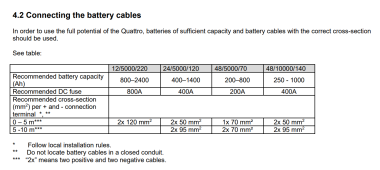Hi all, apologies if this is in the wrong spot, first post on this forum.
I've got my plan mostly finalized for our school bus conversion's solar:

Yes, I know this is an absurdly oversized plan for any normal skoolie. Not particularly looking for verification - though feel free if you'd like, I think I got most of it right.
I'm debating between the following setups to provide 240V split phase:
I'm not really sure which route to go. In my mind, the autotransformer route is the better one - load balancing is automatic and free, the 10kw inverter is more efficient and has a lower zero-load draw than two 5kws. System is easier to expand in the future to larger loads by adding another 10kw instead of two more 5kws. All systems cost about the same. My main concern is any additional losses from the autotransformer; Victron doesn't list an efficiency rating anywhere, and I've read that simple toroidal transformers like this sit between 98-99% efficiency. Hence listing both a 120V source with step-up and a 240V source with step-down; being an American, most loads will be 120V, with only our AC unit and welding machine being 240V.
Thoughts?
I've got my plan mostly finalized for our school bus conversion's solar:

Yes, I know this is an absurdly oversized plan for any normal skoolie. Not particularly looking for verification - though feel free if you'd like, I think I got most of it right.
I'm debating between the following setups to provide 240V split phase:
- Parallel 120V 5kW Quattros (pictured above)
- A single 120V 10kW Quattro paired with a 100A Autotransformer
- A single 240V/60hz 10kW Quattro paired with a 100A Autotransformer
I'm not really sure which route to go. In my mind, the autotransformer route is the better one - load balancing is automatic and free, the 10kw inverter is more efficient and has a lower zero-load draw than two 5kws. System is easier to expand in the future to larger loads by adding another 10kw instead of two more 5kws. All systems cost about the same. My main concern is any additional losses from the autotransformer; Victron doesn't list an efficiency rating anywhere, and I've read that simple toroidal transformers like this sit between 98-99% efficiency. Hence listing both a 120V source with step-up and a 240V source with step-down; being an American, most loads will be 120V, with only our AC unit and welding machine being 240V.
Thoughts?




